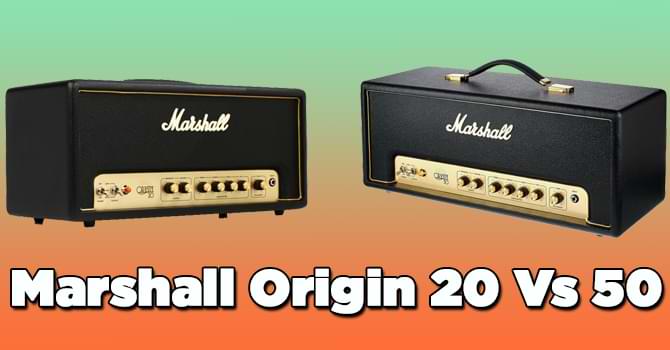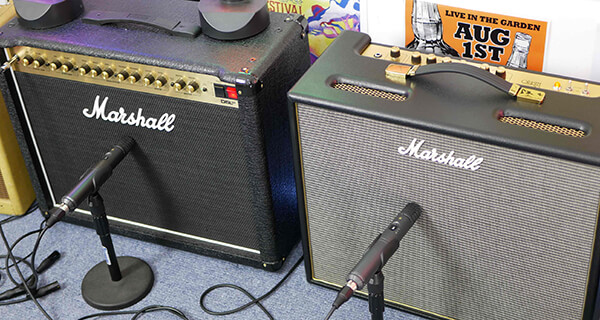Marshall Origin 20 Vs 50 [Difference & Which is Better AMP]
Marshall amplifiers are iconic in the world of music, known for their legendary sound and history. In this comparison, we’ll take a close look at two popular models: the Marshall Origin 20 Vs 50. By the end, you’ll know which one is the right fit for your music needs. Let’s dive into this exploration of Marshall’s classic tone.
# Table of Contents =>

Comparison Table:
| Features – | Marshall Origin 20 | Marshall Origin 50 |
|---|---|---|
| Power Output | 20 watts | 50 watts |
| Speaker | 10″ Celestion V-type | 12″ Celestion Midnight 60 |
| Channels | Single Channel | Single Channel |
| Controls | Gain, Treble, Middle, Bass, Volume, Presence | Gain, Treble, Middle, Bass, Volume, Presence |
| Tube Configuration | 3 x ECC83 (Preamp), 2 x EL34 (Poweramp) | 3 x ECC83 (Preamp), 2 x EL34 (Poweramp) |
| Reverb | Digital Spring Reverb | Digital Spring Reverb |
| Effects Loop | Yes | Yes |
| Line Out | Emulated Line Out with 2×12″ or 4×12″ Cabinet Simulations | Emulated Line Out with 2×12″ or 4×12″ Cabinet Simulations |
| Footswitch Compatibility | Yes, with optional footswitch | Yes, with optional footswitch |
| Dimensions (W x H x D) | 508 mm x 465 mm x 253 mm (20″ x 18.3″ x 9.9″) | 610 mm x 510 mm x 278 mm (24″ x 20″ x 10.9″) |
| Weight | 9.4 kg (20.7 lbs) | 14.55 kg (32.07 lbs) |
| Price Range | $$ – $$$ | $$$ – $$$$ |
Overview of Marshall Origin 20:
Part of the renowned Marshall Origin series, the Marshall Origin 20 aims to encapsulate the core spirit of the iconic Marshall amplifiers of the 1960s. With its 20-watt, all-tube configuration, it embraces a straightforward and unadorned approach to crafting tonal excellence. Let’s delve deeper into its essential attributes:
The Origin 20 packs 20 watts of power, making it suitable for small to medium-sized gigs and studio recording. It’s loud enough to get that classic Marshall overdrive without blowing the roof off. This amp features two ECC83 preamp tubes and three ECC83 power tubes. The tube setup contributes significantly to its classic British sound.
The front panel includes Gain, Bass, Middle, Treble, and Master Volume knobs, as well as a Presence control. It also has a Boost switch to push the amp into higher gain territory. The Origin 20 comes with a single 10-inch Celestion V-Type speaker, known for its vintage tonal characteristics.
Weighing in at around 30 pounds (13.6 kilograms), it’s reasonably portable for a tube amp of its class. The Marshall Origin 20 is generally more budget-friendly compared to higher-wattage models, making it an attractive option for players looking for that iconic Marshall sound without breaking the bank.
Overview of Marshall Origin 50:
Now, let’s turn our attention to the Marshall Origin 50. The Origin 50 delivers 50 watts of power, giving it more headroom for clean tones and the ability to handle larger venues. Similar to the Origin 20, the Origin 50 also uses ECC83 preamp tubes and ECC83 power tubes, preserving that classic tube-driven tone.
The control layout is similar to the Origin 20, with Gain, Bass, Middle, Treble, Master Volume, and Presence knobs, as well as a Boost switch. However, the Origin 50 includes a switchable FX loop, which is a valuable feature for those who like to incorporate effects pedals into their setup. The Origin 50 comes equipped with a 12-inch Celestion G12N-60 Midnight 60 speaker. This larger speaker can contribute to a fuller and louder sound.
As you might expect, the Origin 50 is slightly heavier than the Origin 20, weighing in at approximately 36 pounds (16.3 kilograms). The Origin 50 is typically priced higher than the Origin 20 due to its increased power and additional features.
Main Difference Between The Marshall Origin 20 Vs 50 AMP:
a) Sound Quality:

Now, let’s get to the heart of the matter: sound quality. Both the Marshall Origin 20 and 50 are designed to capture the classic Marshall sound, but they do have some differences in this department.
Marshall Origin 20:
- The Origin 20 is known for its warm and gritty overdrive tones.
- At lower volumes, it can produce sweet, chiming cleans.
- When cranked up, it delivers that unmistakable British crunch that Marshall is famous for.
- It’s an excellent choice for blues, classic rock, and even hard rock styles.
Marshall Origin 50:
- The Origin 50 offers more headroom and clean headroom due to its higher wattage.
- It can provide the same classic Marshall crunch when pushed but does so with a bit more authority and clarity.
- The 12-inch speaker in the Origin 50 contributes to a more pronounced low end and overall fullness.
- This amp is suitable for a wider range of genres, including rock, blues, and even some metal styles when paired with the right pedals.
In terms of sound quality, both amps excel in delivering that iconic Marshall tone, but the Origin 50’s additional power and speaker size give it a slight edge in terms of versatility and projection.
b) Speaker:
The choice of speaker can significantly impact an amplifier’s tone and overall performance. Let’s compare the speakers in the Marshall Origin 20 and Origin 50:
Marshall Origin 20:
- Equipped with a 10-inch Celestion V-Type speaker.
- The V-Type is known for its vintage voicing, with a balanced response and smooth breakup.
- It complements the Origin 20’s 20-watt power output, delivering classic British tones with a sweet midrange.
Marshall Origin 50:
- Features a 12-inch Celestion G12N-60 Midnight 60 speaker.
- The Midnight 60 is designed for modern versatility, with a more extended top end and increased power handling.
- It enhances the Origin 50’s ability to deliver cleaner tones at higher volumes and provides a fuller, more robust sound.
The choice between these speakers ultimately comes down to personal preference. The V-Type in the Origin 20 leans toward vintage tones, while the Midnight 60 in the Origin 50 offers a bit more modern punch and headroom.
c) Weight and Portability:

The weight and portability of an amplifier can be crucial factors, especially if you’re a gigging musician or plan to transport your amp frequently. Here’s how the Marshall Origin 20 and Origin 50 compare in this regard:
Marshall Origin 20:
- Weighs approximately 30 pounds (13.6 kilograms).
- Reasonably portable for a 20-watt tube amp.
- Easy to carry to gigs and rehearsals.
Marshall Origin 50:
- Heavier than the Origin 20, weighing around 36 pounds (16.3 kilograms).
- Still manageable for most players but a bit more cumbersome.
- Offers additional power and features, which can be worth the extra weight for some.
Ultimately, your choice between the two should consider how often you’ll need to transport the amp and whether the extra weight of the Origin 50 is manageable for your needs.
d) Price Comparison:
Finally, let’s talk about the price difference between the Marshall Origin 20 and Origin 50. Price can be a significant deciding factor for many guitarists.
Marshall Origin 20:
- Generally more budget-friendly compared to the Origin 50.
- Offers the classic Marshall sound at a more accessible price point.
- Ideal for players looking for great tone.
Marshall Origin 50:
- Typically priced higher than the Origin 20.
- The added cost reflects its increased power, additional features like the FX loop, and the larger speaker.
- Worth considering if you need the extra power and features.
Your budget will naturally play a role in your decision, but it’s important to remember that both of these amps offer excellent value for the classic Marshall sound they provide.
Which One Is Better for You?
Choose the Marshall Origin 20 if:
- You’re on a budget but still want that iconic Marshall tone.
- You primarily play in smaller venues or at home.
- Portability is a top priority, and you need a lightweight amp for gigging.
Choose the Marshall Origin 50 if:
- You need more power and clean headroom for larger gigs.
- You want the option to incorporate effects pedals easily with the built-in FX loop.
- You prefer a fuller, more modern sound with extended low-end response.
Ultimately, both amplifiers excel at delivering classic Marshall tones, and you can’t go wrong with either choice. Consider your playing style, gigging requirements, and budget when making your decision.
In conclusion, Marshall has a long history of producing iconic amplifiers, and the Origin series carries on that tradition. Whether you opt for the Marshall Origin 20 Vs 50, you’ll be tapping into the rich legacy of British rock and roll tone that Marshall is known for. So, plug in, turn up, and let the Marshall roar!
Last Updated on September 23, 2023 by Perry Garner


